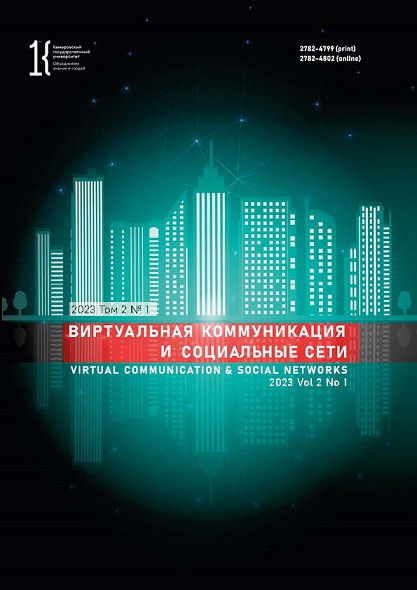Moscow, Russian Federation
Moscow, Russian Federation
Communicative simulation is a virtual practice that reproduces offline forms of social interaction using information and communication technologies. This research parametrized communicative simulation genres and described the interpersonal aspect of virtual interaction in a virtual environment, i.e., bricolage form, intersemiotics, and reduced corporality. Communicative simulations differ from such social practices as offline simulations or role games. The social aspect of communicative simulations includes (1) the media nature of virtual interaction; (2) the hybrid nature of communicative simulations that combines the features of both ordinary simulations and text-based role games; (3) the dual nature of social interaction, carried out simultaneously in material and diegetic spaces. As a result, the social aspect of communicative simulation can be presented in the form of a three-level model: material, diegeological, instrumental levels.
virtual reality, interpersonality, simulations, role-playing games, digital narrative, genres of virtual communication
1. Balakina Ju. V., Sosnin A. V. Intersemioticity and multimedia - from traditional to electronic texts. Sibirskii Filologicheskii Zhurnal, 2017, (1): 161-172. (In Russ.)] https://doi.org/10.17223/18137083/58/16
2. Baudrillard J. In the shadow of the silent majorities, or The end of the social. Ekaterinburg: UrFU, 2000, 96. (In Russ.)]
3. Vilkas È. I. Optimality in games and solutions. Moscow: Nauka. Gl. red. fiz.-mat. lit., 1990, 256. (In Russ.)]
4. Deleuze G. Difference and repetition. St. Petersburg: Petropolis, 1998, 384. (In Russ.)] https://www.elibrary.ru/tcnxlb
5. Dridze T. M. Social communication as a text activity in semiosocial psychology. Obshchestvennye nauki i sovremennost', 1996, (3): 145-152. (In Russ.)]
6. Dridze T. M. Text activity in the structure of social communication: problems of semiosociopsychology. Moscow: Nauka, 1984, 258. (In Russ.)]
7. Zaytseva O. V. Affective aspect of sexting. Vestnik Nizhegorodskogo universiteta im. N. I. Lobachevskogo, 2020, (3): 195-204. (In Russ.)] https://www.elibrary.ru/qauoxv
8. Zaytseva O. V. Somatic code in sexting. Political Linguistics, 2019, (6): 171-181. (In Russ.)] https://doi.org/10.26170/pl19-06-22
9. Zaytseva O. V., Katyshev P. A. Sexting: legal status, expert practice, and narrative features. Social networks: a complex linguistic analysis, eds. Golev N. D., Kim L. G. Kemerovo: KemSU, 2021, vol. 1, 170-190. (In Russ.)] https://www.elibrary.ru/bfahvb
10. Ivanov P. K., Katyshev P. A. Interpersonal potencial of multimodal texts in modern Internet communication. Kul'tura i tekst, 2021, (4): 253-266. (In Russ.)] https://doi.org/10.37386/2305-4077-2021-4-253-266
11. Ivanova Yu. M. Communicative and non-communicative games. Izvestia of Volgograd State Pedagogical University, 2008, (5): 27-31. (In Russ.)] https://elibrary.ru/kcljtx
12. Ivanova Yu. M. Character's concept as the information center in role playing interaction. Vestnik Irkutskogo gosudarstvennogo lingvisticheskogo universiteta, 2009a, (2): 75-80. (In Russ.)] https://elibrary.ru/nqrvxj
13. Ivanova Yu. M. Interaction strategies in a text role-playing game. Bulletin of Chelyabinsk State University, 2009b, (30): 94-101. (In Russ.)] https://elibrary.ru/kwyeqd
14. Ivanova Yu. M. Strategies in communicative game (based on on-line text RPGS). Political Linguistics, 2009c, (1): 159-168. (In Russ.)] https://elibrary.ru/jwuadz
15. Krasnukhina E. K. The bodily presence. Vestnik Sankt-Peterburgskogo universiteta. Seriya 17. Filosofiya. Konfliktologiya. Kul'turologiya. Religiovedenie, 2015, (2): 21-26. (In Russ.)] https://elibrary.ru/uhvglt
16. Petriashin S. S. Distributed personality and virtual corporeality. Technologies and corporeality, ed. Sokolovskiy S. V. Moscow: IEA RAS, 2018, 169-206. (In Russ.)] https://elibrary.ru/ymnpdf
17. Sorokin Yu. A., Tarasov E. F. Creolized texts and their communicative function. Optimization of speech communication, ed. Kotov R. G. Moscow: Nauka, 1990, 180-186. (In Russ.)] https://elibrary.ru/uwkfkr
18. Tsygankova P. V., Suvorova E. Yu. Live-action role-playing games and online role-playing games: psychological functions in the modern sociocultural context. Vestnik Permskogo universiteta. Filosofia. Psihologia. Sociologia, 2020, (3): 459-474. (In Russ.)] https://doi.org/10.17072/2078-7898/2020-3-459-474
19. Shkarin D. L. Level analysis of ASMR technology and ascertaining its place in the contemporary social context. Vestnik Permskogo universiteta. Filosofia. Psihologia. Sociologia, 2018, (1): 79-87. (In Russ.)] https://doi.org/10.17072/2078-7898/2018-1-79-87
20. Schmid W. Narratology. Moscow: Yazyki slavyanskikh kul'tur, 2003, 312. (In Russ.)]
21. Deterding S., Zagal J. P. The many faces of role-playing game studies. Role-playing game studies: transmedia foundations. 1st ed. NY: Routledge, 2018, 1-16. http://dx.doi.org/10.4324/9781315637532-1
22. Giambiasi N., Escude B., Ghosh S. GDEVS: a Generalized Discrete Event Specification for accurate modeling of dynamic systems. Proceedings 5th International Symposium on Autonomous Decentralized Systems. Dallas, 26-28 Mar 2001. IEEE, 2001, 464-469. https://doi.ieeecomputersociety.org/10.1109/ISADS.2001.917452
23. Gunawardena C. N. Social presence theory and implications for interaction and collaborative learning in computer conferences. International Journal of Educational Telecommunications, 1995, 1(2/3): 147-166.
24. Gunawardena C. N., Zittle F. J. Social presence as a predictor of satisfaction within a computer-mediated conferencing environment. American Journal of Distance Education, 1997, 11(3): 8-26. https://doi.org/10.1080/08923649709526970
25. Harper P. C. ASMR: bodily pleasure, online performance, digital modality. Sound Studies, 2020, 6(1): 95-98. https://doi.org/10.1080/20551940.2019.1681574
26. Hyland K. Constructing proximity: relating to readers in popular and professional science. Journal of English for Academic Purposes, 2010, 9(2): 116-127. https://doi.org/10.1016/j.jeap.2010.02.003
27. Ihde D. Postphenomenology and technoscience: the Peking University lectures. Albany: SUNY Press, 2009, 102.
28. Kuhl F., Weatherly R., Dahmann J. Creating computer simulation systems: an introduction to the high-level architecture. Prentice Hall PTR, 1999, 212.
29. McLeod J. Simulation: the dynamic modeling of ideas and systems with computers. NY: McGraw-Hill, 1968, 351.
30. Meyrowitz J. Multiple media literacies. Journal of Communication, 1998, 48(1): 96-108. https://doi.org/10.1111/j.1460-2466.1998.tb02740.x
31. Meyrowitz J. No sense of place: the impact of electronic media on social behavior. NY-Oxford: Oxford University Press, 1986, 432.
32. Short J., Williams E., Christie B. The social psychology of telecommunications. London-NY: John Wiley & Sons, 1976, 195.
33. Vasconcelos V. V., Seingyai A. Planning for sustainable development: a simulation game. Applied Environmental Education & Communication, 2022, 21(1): 42-54. https://doi.org/10.1080/1533015x.2021.1936299
34. Walther J. B. Computer-mediated communication: impersonal, interpersonal, and hyperpersonal interaction. Communication Research, 1996, 23(1): 3-43. https://doi.org/10.1177/009365096023001001


















